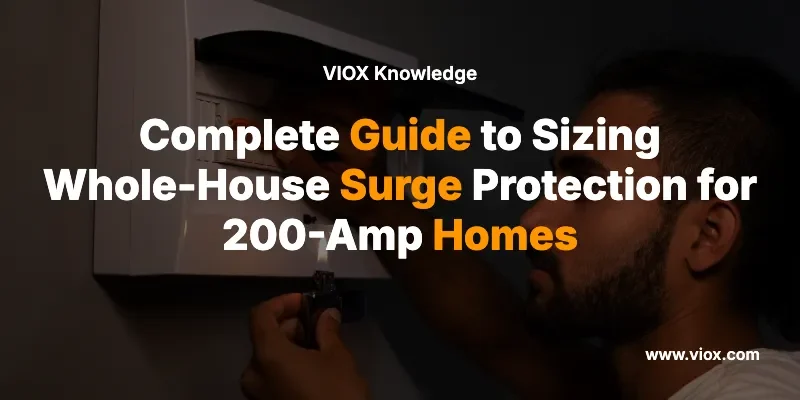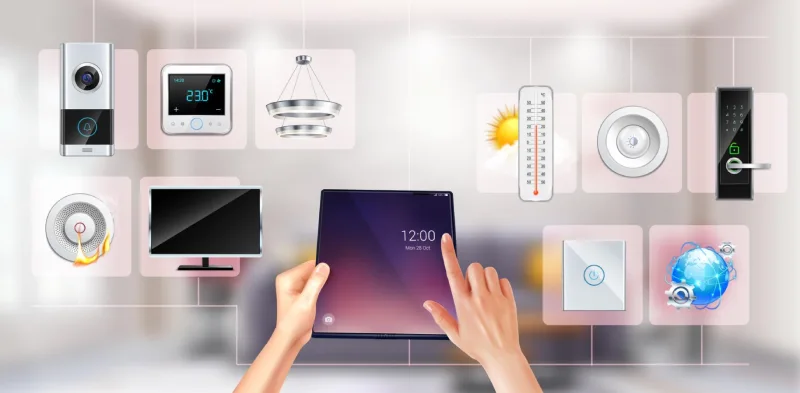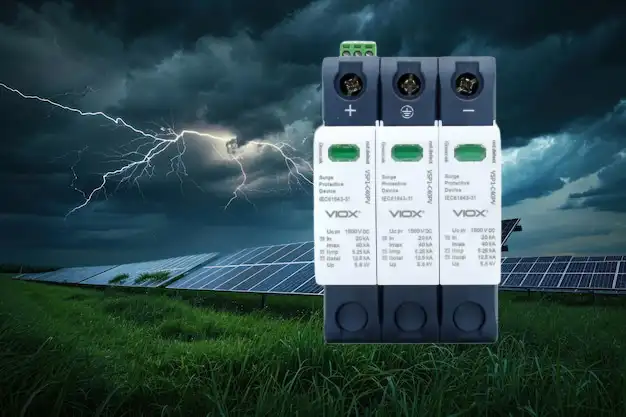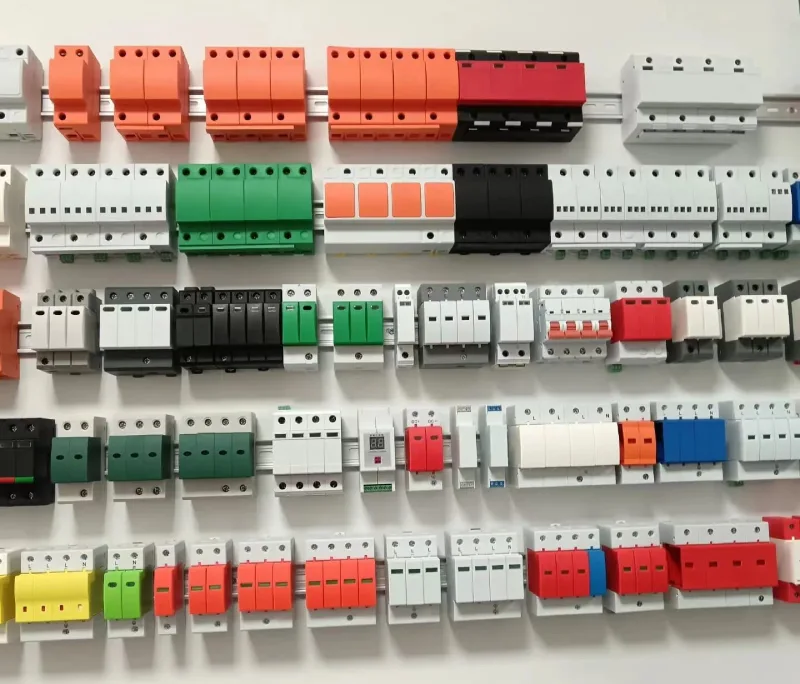When “Good Enough” Protection Isn’t Good Enough
You’ve done everything right. Your 200-amp electrical service was professionally installed. Your smart home system controls everything from lighting to HVAC. Your home office has $15,000 in computers and displays. Your kitchen gleams with premium appliances. Life is good.
Then, on a Tuesday afternoon, a transformer failure two blocks away sends a massive voltage spike through your neighborhood. In less than a second, your router is dead. Your smart thermostat won’t boot. Your refrigerator’s control board is fried. The home theater? Completely bricked. The damage estimate: $34,000.
The worst part? You had a surge protector—a “whole-house” unit your electrician installed three years ago. But it was a 40kA model designed for a small apartment, not a modern 200-amp home with high-end electronics. It was overwhelmed instantly.
So here’s the question that matters: How do you properly size surge protection so you never get that devastating call—and how do you avoid wasting money on excessive capacity you don’t need?
Why Most Surge Protectors Fail When You Need Them Most
The dirty secret of residential surge protection is this: most installations are sized incorrectly from day one.
Here’s what typically happens: A homeowner asks their electrician for “a surge protector.” The electrician installs whatever they have on the truck—usually a mid-range 60-80kA unit—without analyzing the home’s actual risk profile, electronics value, or local surge conditions. It’s installed correctly, carries a UL 1449 sticker, and everyone feels protected.
Until a real surge hits.
The problem isn’t the electrician’s competence—it’s that surge protector sizing isn’t a one-size-fits-all decision. A 200-amp service panel tells you about your home’s power capacity, but it says nothing about your surge vulnerability. The home might be a 2,000 square-foot ranch with basic appliances, or a 5,000 square-foot smart home with $100,000 in integrated systems. Both have 200-amp service. Both need radically different protection.
Pro-Tip #1: The 200-amp trap—Don’t let panel size be your only sizing factor. A 200-amp home in rural Montana with minimal electronics needs far less protection than a 200-amp home in Florida with whole-home automation. Panel amperage sets the minimum requirement, not the target.
The Solution: A Three-Factor Surge Protection Sizing Method
The answer isn’t to just “buy the biggest one.” It’s to match your protection to three specific factors: your home’s electrical infrastructure, your electronics portfolio, and your local surge environment. When these align with the right kA rating, clamping voltage, and response time, you get protection that works when it matters—without overpaying for capacity you’ll never use.
Let’s break down exactly how to size protection for a 200-amp home using a systematic approach that considers all three factors.
The Complete Sizing Framework: How to Select the Right Surge Protection
Step 1: Establish Your Base Protection Level Using Panel Size
Start with your electrical service size to determine your baseline surge capacity requirement. For a 200-amp residential service, this establishes your minimum threshold.
Baseline Recommendations by Panel Size:
| Electrical Service | Minimum Surge Capacity | Typical Application |
|---|---|---|
| 100-150 amps | 40-60 kA | Smaller homes, basic appliances |
| 200 ایم پی ایس | 60-80 kA | Average modern home |
| 200+ amps (high-end) | 100-120 kA | Large homes, high-demand systems |
For most 200-amp homes, 60-80kA is your starting point. This handles typical surges from utility switching, nearby lightning strikes, and equipment cycling on your street’s transformer.
But don’t stop here. This is just the foundation. Steps 2 and 3 determine if you need to move up or down from this baseline.
Pro-Tip #2: Why 200 amps doesn’t automatically mean 100kA—Your panel’s amperage describes sustained load capacity, not surge vulnerability. A 200-amp service can run a large home’s continuous electrical demand, but surge risk is determined by what’s plugged in, not what’s available. Save money by right-sizing, not over-sizing.
Step 2: Adjust for Your Electronics Portfolio and Risk Exposure
Now overlay your actual equipment value and vulnerability. This is where most people get sizing wrong—they either under-protect expensive gear or over-protect basic loads.
Calculate Your Electronics Risk Factor:
Ask yourself these questions:
- High-value electronics? Do you have $20,000+ in computers, displays, servers, audio/video equipment, or medical devices?
- Integrated smart systems? Is your home automation, security, HVAC, and lighting controlled by networked devices that would cost $10,000+ to replace and reprogram?
- Sensitive HVAC equipment? Do you have variable-speed heat pumps, multi-zone mini-splits, or geothermal systems with expensive control boards?
- Commercial-grade appliances? Does your kitchen include built-in espresso systems, wine refrigerators with digital controls, or professional ranges with electronic ignition?
If you answered “yes” to two or more, move up one protection tier from your baseline. A standard 200-amp home would jump from 60-80kA to 100-120kA.
If you answered “no” to all of them, you might even consider staying at the lower end of your baseline range (60kA rather than 80kA), especially if Step 3 indicates low surge frequency.
Pro-Tip #3: The vulnerability multiplier—Don’t just count the dollar value of your electronics. Consider replacement cost plus downtime cost. A $3,000 home server might store $50,000 worth of work. A $5,000 smart home system might take weeks to reprogram. Protection is insurance: size it for total exposure, not just hardware cost.
Step 3: Factor in Local Surge Conditions and Environmental Risk
The final variable is where you live. Surge frequency varies dramatically by geography, and this should push your final selection up or down.
High-Risk Locations (require higher protection):
- Lightning-prone regions: Florida, Gulf Coast, Mountain West, Great Lakes
- Unstable grid areas: Regions with frequent utility outages, older infrastructure, or rural areas with long distribution lines
- Proximity to industrial loads: Near factories, data centers, or facilities with large motors that cycle frequently
Lower-Risk Locations (can use baseline or slightly lower):
- Urban areas with underground utilities and modern grid infrastructure
- Regions with low annual lightning strike density
- Stable power grids with few outages or flickers
Here’s how to adjust:
- High-risk location + high-value electronics? Add 20-40kA to your Step 2 recommendation. (Example: 80kA baseline becomes 100-120kA)
- Low-risk location + basic electronics? You can comfortably stay at the lower end of your baseline. (Example: 60kA is sufficient rather than 80kA)
Pro-Tip #4: The forgotten factor—Your ZIP code matters more than your panel size. A 200-amp home in Tampa (lightning capital of the U.S.) faces 10x the surge risk of an identical home in Seattle. Check your local lightning density maps and utility reliability data before finalizing your selection. The investment in a 100kA unit pays for itself after one prevented strike.
Step 4: Verify Critical Technical Specifications Beyond kA Rating
Once you’ve determined your target surge capacity using Steps 1-3, confirm your selected unit meets these additional performance criteria. A high kA rating is useless if the device responds too slowly or allows too much voltage through.
Critical specs to verify:
Clamping Voltage (Voltage Protection Rating):
- Target: 400V or lower (measured under UL 1449 testing)
- This is the voltage level at which the protector activates. Lower is better.
- Many cheap units clamp at 600-800V, allowing damaging voltage to reach sensitive electronics.
- Why it matters: Modern electronics, especially computers and smart devices, can be damaged by voltage as low as 330V. A 600V clamping voltage means your equipment is exposed to nearly double the safe threshold before protection kicks in.
جواب کا وقت:
- Target: Under 1 nanosecond
- Faster response time means less voltage reaches your equipment during the initial surge phase.
- Quality units respond in picoseconds; budget units can take 3-5 nanoseconds.
UL 1449 4th Edition Certification:
- Non-negotiable. This certification proves the unit has been tested for safety and performance under real-world surge conditions.
- Verify the unit is rated as a Type 1 (service entrance) or Type 2 (load center) protector.
Maximum Continuous Operating Voltage (MCOV):
- Must match your system voltage. For residential 240V split-phase service, look for MCOV of 150V L-N (line-to-neutral) and 300V L-L (line-to-line).
Indicator Lights and Diagnostics:
- LED status indicators tell you if protection is active or if the unit has been compromised.
- Some advanced units include audible alarms or remote monitoring capabilities.
وارنٹی:
- Quality manufacturers offer equipment protection warranties ($25,000-$100,000 coverage) for connected equipment damage.
- Also check the protector’s own product warranty (typically 5-10 years).
Pro-Tip #5: The spec sheet matters more than the sales pitch—A 120kA protector with 800V clamping voltage and slow response is inferior to an 80kA unit with 400V clamping and sub-nanosecond response. Don’t be blinded by the headline kA number. Demand to see the full UL 1449 test report, especially clamping voltage across all modes (L-N, L-L, L-G).
Real-World Sizing Examples: Putting It All Together
Let’s walk through three actual 200-amp homes to see how the framework works in practice:
Example 1: Suburban Family Home (Indianapolis, IN)
- 200-amp service
- Basic electronics: laptops, TVs, standard appliances
- Single-stage HVAC
- Moderate lightning risk area
Recommendation: 60-80kA (baseline, no adjustment needed)
Estimated cost: $400-600 installed
Example 2: Smart Home (Tampa, FL)
- 200-amp service
- $40,000 in whole-home automation, networked HVAC, security systems
- High lightning frequency (80+ strikes per square mile annually)
- Frequent utility outages
Recommendation: 100-120kA (baseline + electronics risk + location risk)
Estimated cost: $800-1,200 installed
Example 3: Rural Home (Montana)
- 200-amp service
- Basic appliances, minimal electronics
- Long distribution lines (unstable power)
- Low lightning frequency
Recommendation: 60-80kA (baseline sufficient; location reduces risk but utility instability keeps it in range)
Estimated cost: $400-600 installed
Installation and Layered Protection: Making Your Investment Work
Selecting the right surge capacity is only half the battle. Professional installation and layered protection are what turn a good surge protector into comprehensive defense.
Why Professional Installation Is Non-Negotiable
Whole-house surge protectors connect directly to your main electrical panel or service entrance. This is not a DIY project for three critical reasons:
- کوڈ کی تعمیل: Most jurisdictions require licensed electricians to work inside electrical panels.
- Proper bonding and grounding: Surge protectors rely on your home’s grounding system to divert excess voltage safely. If grounding is inadequate, protection fails.
- Correct placement: The protector must be installed at the right location (typically on a dedicated breaker) to intercept surges before they enter your home’s wiring.
A poorly installed 120kA unit provides less protection than a properly installed 60kA unit.
The Layered Defense Strategy: Whole-House + Point-of-Use
Even the best whole-house protector can’t stop every damaging surge—especially smaller transients generated inside your home (appliance cycling, motor startups, etc.). That’s why smart protection uses layers:
Layer 1: Whole-House Protection (Primary Defense)
- Stops large external surges from utility lines and lightning strikes
- Protects all circuits and hard-wired equipment
- Your main line of defense against catastrophic damage
Layer 2: Point-of-Use Protection (Secondary Defense)
- Individual surge strips or outlet protectors for sensitive electronics
- Handles smaller surges and any voltage that slips past the whole-house unit
- Especially important for computers, home theater equipment, and networking gear
Pro-Tip #6: The 80/20 protection rule—Your whole-house protector handles 80% of surge events and 95% of surge energy. Point-of-use protectors catch the remaining 20% of events and that critical last 5% of energy that could still fry sensitive circuits. Budget for both: $800 for whole-house + $200-300 for quality point-of-use units on key equipment.
Ongoing Maintenance: Keeping Protection Active
Surge protectors don’t last forever. Each surge they intercept degrades their protective components. Follow these maintenance steps:
- Check status lights monthly. Most units have LED indicators showing protection status.
- Test after major surges. If your area experiences a direct lightning strike or major utility event, verify your protector is still functional.
- Replace every 5-10 years. Even without major surge events, protective components degrade over time.
- Verify grounding annually. Have your electrician test your home’s grounding system to ensure it meets current code requirements.
Avoid These Common Sizing Mistakes
Before you make your final selection, watch out for these traps:
- Mistake 1: “I have 200 amps, so I need a 200kA protector.” Panel amperage and surge capacity aren’t directly related. A 200-amp panel doesn’t generate 200kA surges. Size based on vulnerability, not panel rating.
- Mistake 2: “The cheapest 80kA unit is fine—kA is all that matters.” A budget 80kA protector with 800V clamping voltage and no UL 1449 certification is nearly worthless. Verify all specs.
- Mistake 3: “One surge protector covers everything.” Whole-house protection is essential, but sensitive electronics need point-of-use backup protection.
- Mistake 4: “I’ll install it myself and save $200.” Improper installation voids warranties, violates codes, and can leave you completely unprotected. Always hire a licensed electrician.
- Mistake 5: “Once installed, I’m protected forever.” Surge protectors degrade with each surge event. Check status indicators and plan for eventual replacement.
Summary: Right-Sizing Your Surge Protection
Protecting your 200-amp home from electrical surges isn’t about buying the biggest unit or the cheapest one—it’s about methodically matching protection to your actual risk profile. By following this three-step framework, you can:
- ✓ Start with your electrical service size to establish baseline protection (60-80kA for most 200-amp homes)
- ✓ Adjust for your electronics portfolio to account for high-value or sensitive equipment (move to 100-120kA if needed)
- ✓ Factor in local surge conditions based on lightning frequency and grid stability (add 20-40kA in high-risk areas)
- ✓ Verify critical specs beyond kA rating: clamping voltage ≤400V, UL 1449 certification, sub-nanosecond response time
- ✓ Layer your defense with whole-house protection plus point-of-use units for sensitive equipment
- ✓ Invest in professional installation to ensure proper bonding, grounding, and code compliance
The cost difference between a 60kA and 120kA unit might be $300-400. The cost of replacing destroyed electronics, data loss, and downtime after a surge can easily exceed $50,000. This isn’t an area to cut corners—but it’s also not an area to wildly over-spend based on guesswork.
Take action now. Review your home’s current protection (or lack thereof) using this framework. Consult with a licensed electrician who understands surge protection—not just someone who installs “whatever’s on the truck.” And remember: the best time to install surge protection is before the next storm, not after.
Your home’s electronics, appliances, and systems are depending on you to get this right. Now you have the knowledge to do exactly that.
Need expert help sizing and installing whole-house surge protection? Contact a licensed electrician who specializes in power quality and surge protection. Bring this guide with you to ensure they consider all three sizing factors—not just your panel amperage. Your investment deserves protection that actually works when you need it most.





